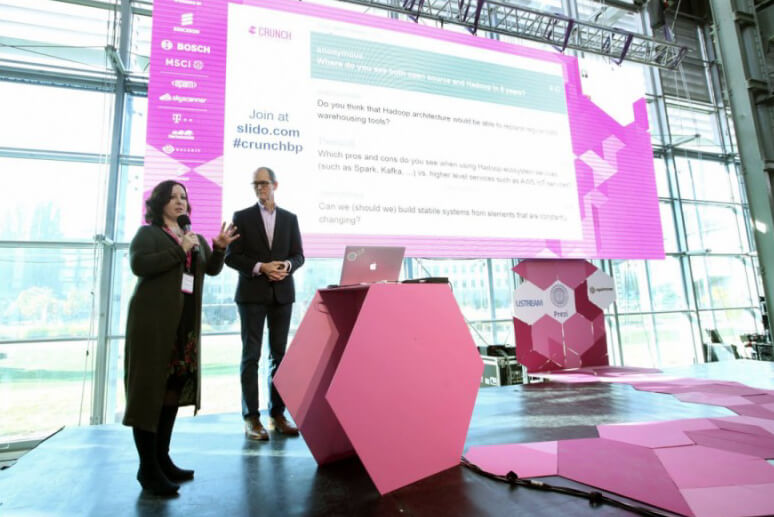Many Q&A sessions are like a weather forecast: you know roughly what to expect but you don’t know what you’ll get on the day.
But if it is well planned, the Q&A session can become the highlight for all attendees.
To deliver a memorable Q&A session that adds value to your participants, certain elements need to be handled attentively.
Here at Slido, Q&A sessions are one of the main reasons for our existence. We’ve helped power interaction at over 100,000 events, and we have learned a lot from them.
Below, we share 8 tips that we’ve gathered for running better Q&A sessions. We hope you’ll find them useful.
Before the event
Brief your moderator and facilitator
Briefing your moderator and facilitator is crucial for driving interaction at your Q&A session.
You can think of your moderator as the voice of the audience, which drives and steers the conversation between presenters and attendees.
We’ve discovered that only 19% of event professionals involve moderators in the pre-planning phase.
It’s useful to involve your moderator as early as the pre-planning phase so he or she can help you influence the format and flow.
To help us understand what moderators expect from a useful briefing, we asked some experts and here are the key points they shared with us:
- Timings: Specify the length of the Q&A and explain how much time there will be for the audience questions.
- Structure and agenda: In case they will moderate the entire event, give them a detailed agenda and clarify how many Q&A sessions and panel discussions you will hold.
- Event technology: Explain how you will collect audience questions. If you’re using a live Q&A tool, brief the moderator on how it works and ask him or her to introduce the tool at the start.
Extra Tip: It will help if you can show or demo the tool in action.
Synchronize with your speakers
Just like briefing your moderator, it’s critical to synchronize with your speakers before the event starts.
If the moderator is the Q&A driver, the speakers are like the wheels that will carry the discussion forward.
Ensure the speakers know the length of their time slot and how you plan to run the Q&A session.
If you are using event technology, inform them in advance about how it works. You can dedicate a small paragraph in your instructions email, send them a video, or even get them on a webinar.
Extra Tip: Once onsite, you can share a few pre-prepared questions with them and run a mock Q&A before the event kicks off. We’ve seen this practice at many events we’ve attended.
For example, at the Marketing Festival in the Czech Republic, the moderator showed the speakers where the Q&A sessions would take place and ran a mock session with them before the event got underway. It helped the speakers feel more comfortable and confident during the real discussion.

Build in enough time for Q&A
Dedicating 5 minutes for Q&A is not enough. To make the Q&A useful at all, make sure to build in enough time for the discussion to evolve.
The ratio will depend on your event format, type of session, audience size and number of speakers. For hour-long keynotes, WOBI dedicates around 15 minutes and SXSW around 10 minutes to the Q&A.
As a good rule of thumb, dedicate at least one-fourth of the slot to the Q&A.
Sometimes, the packed agenda does not allow for a Q&A slot after every speaker. To address this, the organizers of SLUSH and StartUp Grind created a separate Q&A stage.
At StartUp Grind, the speakers addressed audience questions collected through Slido in interactive 30-minute “Ask Me Anything” sessions.
Extra Tip: To bring more diversity and interaction into your agenda, consider adjusting the format and switching to solely Q&A-driven sessions such as “Ask Me Anything” or fireside chats.

Prepare some questions in advance
Event organizers know that preparation is the backbone of success. To help kickstart the discussion and avoid awkward silences, prepare some questions in advance.
If you’re using a Q&A platform, submit a few questions once the session gets underway. It will inspire the attendees to follow the lead and submit their own, or if they don’t have any questions, to upvote the ones that they want to hear addressed.
Last year’s Festival of Marketing in London did this really well.
The organizers came up with 2-3 questions for each of the nearly 150 sessions they ran and submitted them through Slido at the start of the sessions. Doing so prompted the attendees to interact with the questions by voting for the ones they liked and start submitting their own questions.
Give clear instructions to the AV team
For your AV team, Q&A sessions (powered by technology) are another element that they need to prepare for. And you need their buy-in.
Once everything is planned, review the Run of Show with your AV team and mark the sessions with the Q&A.
Give the AV team clear instructions on when to display the questions on the screens. If you’re having multiple stage screens, decide which ones will be used for showing the audience questions.
The main screen, side screens, confidence monitor, or a combination?
The ideal setup is to display questions for the audience on the stage monitors so they can see them and follow the discussion easily. For the speakers, you can display the questions on the confidence monitor so they don’t need to turn their heads.
As for the moderators, they can either read them from the confidence monitors or you can equip them with a tablet where they’ll be able to view the most upvoted questions.
During the event
Introduce the Q&A platform at the start
To get people to use a Q&A platform, have your moderator introduce it right at the start and invite people to submit their questions.
Extra Tip: Run a warm-up poll as part of the introduction to get people to open the tool and get familiar with it.
The first session with the tool is critical. If you get that one right, people will learn how it works and will continue sending questions in the sessions to come.
Later on, it’s a great practice to remind people to submit questions before each session that includes the use of a Q&A platform. If there are presentations where you’re not planning to use a Q&A tool, announce it at the start of such sessions to avoid frustration.

Address the audience questions
Once you’ve collected some questions, don’t ignore them. Instead, plug them into the conversation to make your attendees heard.
This goes back to the moderator briefing. A well-instructed moderator will remember to keep an eye on the incoming questions via the Q&A platform and include them at the right moment during the discussion.
When taking audience questions, keep a good balance between taking questions submitted through a Q&A platform and giving the people in the room the opportunity to comment or ask a follow-up question.

Keep an eye on the time
Skilled moderators keep an eye on the time and stick to the agenda as much as possible.
But if you’re running out of time, prompt the audience to vote for their most favourite questions submitted through the Q&A platform. Then you can address the top-voted questions to ensure the process is as democratic as possible.
If there is no time for questions at all, make sure to at least comment on the already submitted questions so people don’t feel discouraged to submit questions next time.
Extra Tip: You can invite the speakers to respond to the outstanding questions after the event and share the answers with the attendees.
Wrap up
The best Q&A sessions give the attendees a voice, create space for interaction and enhance their learning experience. Fix the Q&A at your event and turn it into a better experience with these 8 tips. Implementing these steps will help you maximize your Q&A session’s potential and add value to all participants.




